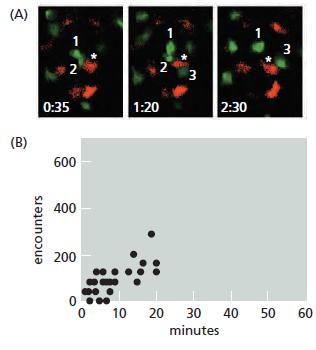Before exposure to a foreign antigen, T cells with receptors specific for the antigen are a tiny
Question:
Before exposure to a foreign antigen, T cells with receptors specific for the antigen are a tiny fraction of the T cells—on the order of 1 in 105 or 1 in 106 T cells. After exposure to the antigen, only a small number of dendritic cells typically display the antigen on their surface. How long does it take for such antigen-presenting dendritic cells to interact with the antigen-specific T cells, which is the key first step in T cell activation and clonal expansion? The dynamics of the search process were examined by labeling dendritic cells red and T cells green, so that contacts in an intact lymph node could be scored visually using two-photon fluorescence microscopy (Figure Q24–3A). The frequency of contacts between dendritic cells and T cells from such experiments is given in Figure 24–3B. Assuming that 100 dendritic cells present the specific antigen, how long would it take them to scan 105 T cells? How long for 106 T cells?
Figure Q24-3

Step by Step Answer:

Molecular Biology Of The Cell
ISBN: 9780815344322
6th Edition
Authors: Bruce Alberts, Alexander D. Johnson, Julian Lewis, David Morgan, Martin Raff, Keith Roberts, Peter Walter




